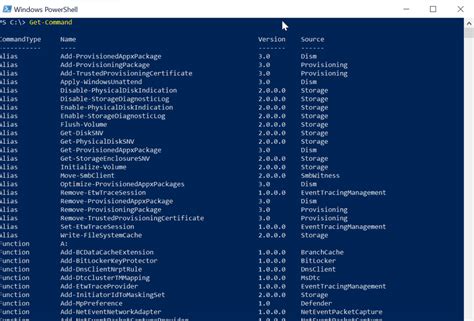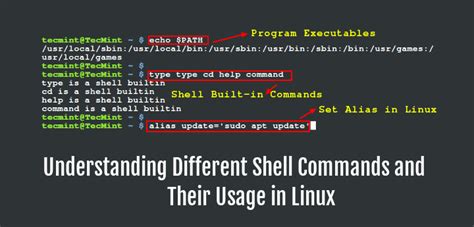10 Tips: View Top Used Shell Commands

Shell commands are an integral part of any Unix-like operating system, offering a powerful and efficient way to manage and interact with the system. Whether you're a seasoned system administrator or a curious user, knowing the most commonly used shell commands can greatly enhance your productivity and understanding of the command-line interface. In this article, we delve into the world of shell commands, presenting a curated list of the top used commands and exploring their functionality, use cases, and best practices.
Mastering the Command Line: A Comprehensive Guide

The command line, often referred to as the terminal or shell, provides a text-based interface for interacting with the operating system. It is a powerful tool that allows users to perform a wide range of tasks, from simple file management to complex system administration. By mastering the command line, users can unlock a world of efficiency and control over their systems.
This guide aims to provide a comprehensive overview of the most frequently used shell commands, offering practical examples and insights to help users navigate the command-line interface with confidence. Whether you're a developer, system administrator, or a curious learner, these tips will empower you to make the most of the command line, streamline your workflow, and troubleshoot effectively.
Top 10 Shell Commands: Unlocking Efficiency

Shell commands are the building blocks of command-line interaction, and understanding the most commonly used ones is essential for any command-line user. Here, we present the top 10 shell commands, accompanied by detailed explanations and practical examples to help you harness their full potential.
1. ls: Listing Directory Contents
The ls command is one of the most frequently used shell commands, allowing users to list the contents of a directory. With various options, ls can provide detailed information about files and directories, including permissions, ownership, and modification dates. It is an indispensable tool for navigating and exploring the file system.
ls -l /path/to/directory
The above command lists the contents of the specified directory in long format, providing detailed information about each file and directory.
2. cd: Changing Directories
The cd command is essential for navigating the file system. It allows users to change their current working directory, moving between different directories effortlessly. With cd, users can quickly access specific directories, making it a fundamental command for command-line navigation.
cd /path/to/directory
This command changes the current working directory to the specified path.
3. cat: Concatenating and Viewing Files
The cat command is a versatile tool used for concatenating and displaying the contents of files. It allows users to quickly view the contents of a file, making it especially useful for checking text files, configuration files, and log files. With cat, users can easily inspect and analyze file contents without the need for additional tools.
cat /path/to/file.txt
The above command displays the contents of the specified file.
4. cp: Copying Files and Directories
The cp command is an essential tool for file management, allowing users to copy files and directories from one location to another. With various options, cp provides flexibility in copying, enabling users to preserve permissions, ownership, and other attributes during the copy process.
cp -r /path/to/source/directory /path/to/destination/directory
This command copies the source directory, including all its subdirectories and files, to the destination directory.
5. mv: Moving and Renaming Files
The mv command serves a dual purpose: it can move files and directories from one location to another, and it can also rename files. This versatility makes mv an indispensable tool for file management, enabling users to organize and rearrange their files efficiently.
mv /path/to/file.txt /path/to/new/location/file.txt
The above command moves the file file.txt to a new location, effectively renaming it in the process.
6. rm: Removing Files and Directories
The rm command is used for removing files and directories from the file system. With options to remove multiple files, directories, and even force removal, rm provides users with the necessary tools to manage and free up disk space efficiently.
rm -r /path/to/directory
This command removes the specified directory and all its contents, including subdirectories and files.
7. mkdir: Creating Directories
The mkdir command is a simple yet powerful tool for creating new directories. With the ability to create multiple directories at once and specify parent directories, mkdir is an essential command for organizing and structuring the file system.
mkdir -p /path/to/new/directory
The above command creates the specified directory, along with any necessary parent directories.
8. grep: Searching for Text in Files
The grep command is a powerful text-searching tool, allowing users to search for specific patterns or strings within files. With options to ignore case, search recursively, and output line numbers, grep is an invaluable command for finding specific information within large text files or log files.
grep "search_string" /path/to/file.txt
This command searches for the specified search_string within the file file.txt, displaying the matching lines.
9. ps: Viewing Running Processes
The ps command provides a snapshot of the current running processes on the system. With various options, ps can display detailed information about processes, including their process IDs, memory usage, and command names. It is an essential tool for monitoring and managing system processes.
ps aux
The above command displays a comprehensive list of all running processes on the system.
10. kill: Terminating Processes
The kill command is used to terminate running processes. With the ability to specify process IDs or process names, kill provides a powerful way to manage and control system processes, allowing users to gracefully or forcibly terminate unwanted or unresponsive processes.
kill -9 process_id
This command terminates the process with the specified process_id, using the SIGKILL signal.
Best Practices and Tips
While these top 10 shell commands offer a solid foundation for command-line interaction, there are several best practices and tips to enhance your command-line experience.
- Use Aliases: Create aliases for frequently used commands to save time and effort. For example,
alias ll='ls -l'creates an alias ll for the ls command with the -l option. - Tab Completion: Utilize tab completion to quickly and accurately complete file paths, command names, and options. Pressing Tab multiple times will cycle through available options.
- Pipe Commands: Combine multiple commands using pipes (
|) to create powerful command chains. For example,ls -l | grep "search_string"lists directory contents and pipes the output to grep for searching. - Learn Man Pages: Familiarize yourself with the man pages (manual pages) for each command. These pages provide detailed information about command options, syntax, and examples.
- Practice and Experiment: The command line is a powerful tool, and the best way to learn is by practicing and experimenting. Try out new commands, explore their options, and don't be afraid to make mistakes – it's all part of the learning process.
Conclusion: Unlocking Command-Line Mastery
The command line is a versatile and powerful interface, and by mastering the top used shell commands, users can unlock a world of efficiency and control over their systems. From file management to process control, these commands form the backbone of command-line interaction. With practice and exploration, users can become proficient in navigating and managing their systems, leveraging the full potential of the command line.
Remember, the command line is a powerful tool, and with the right knowledge and skills, it can become an invaluable asset in your computing toolkit. So, embrace the command line, explore its capabilities, and unlock the true potential of your Unix-like operating system.
What are shell commands, and why are they important?
+Shell commands are instructions or commands executed within a shell or terminal environment. They allow users to interact with the operating system, manage files and directories, control processes, and perform a wide range of tasks. Shell commands are important because they provide a powerful and efficient way to automate tasks, manage systems, and troubleshoot issues.
How can I learn more about specific shell commands?
+To learn more about specific shell commands, you can refer to their respective man pages (manual pages) by typing man command_name in the terminal. Man pages provide detailed information about command syntax, options, and examples. Additionally, online resources, tutorials, and books can offer comprehensive guides and tips for mastering shell commands.
Are there any security considerations when using shell commands?
+Yes, security is an important aspect when using shell commands. Always be cautious when executing commands, especially those with elevated privileges or those that modify system settings. It’s crucial to understand the potential impact of a command before running it. Additionally, be mindful of potential security vulnerabilities associated with certain commands and take appropriate measures to mitigate risks.



